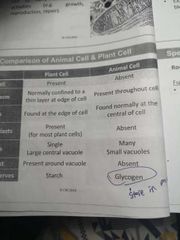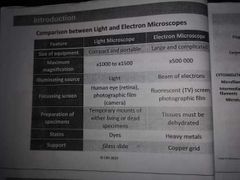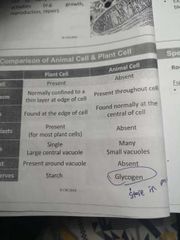![]()
![]()
![]()
Use LEFT and RIGHT arrow keys to navigate between flashcards;
Use UP and DOWN arrow keys to flip the card;
H to show hint;
A reads text to speech;
47 Cards in this Set
- Front
- Back

|
Revision |
|
|
Define Taxonomy |
Taxonomy is the study of scientific identification and classification of living organisms. |
|
|
How would you handwrite the scientific name if humans? |
-Capital letter for Genus while small letter for species -Underline if handwrite |
|
|
Purpose of the binomial nomenclature system |
- To provide a consistent way to name species - To ensure each species has a different and unique name - To avoid confusion that occurs when using common names |
|
|
Name the 7 taxonomy groups and their characteristics |
KINGDOM (Little common characteristics) PHYLUM (Similar body plan) CLASS (Common attribute) ORDER (Similar nature and character) FAMILY (More common attributes) GENUS (Similar and closely related) SPECIES (Capable of interbreeding to produce fertile offsprings) |
|
|
Name the 5 kingdoms |
Prokaryotae/Monera Protista Fungi Plantae Animalia |
|
|
Name the 3 Domains |
Bacteria Archaea Eukarya |
|
|
Characteristics of domain Bacteria |
- Peptidoglycan cell wall - Prokaryote ---> Lacks True Nucleus - 0.5 - 5.0 micrometre |
|
|
Characteristics of Domain Archaea |
- Bacteria that lack Peptidoglycan cell walll - Prokaryote ---> Lacks True Nucleus - Harsh Habitats |
|
|
Characteristics of Domain Eukarya |
- Separated into four kingdoms: Protista, Plantae, Fungi, Animalia - Eukaryote---> True Nucleus |
|
|
Kingdom Protista (Protozoans) |
- "Others" section - Commonly in moist environments - Parasitic Protozoa causes diseases |
|
|
Kingdom Fungi |
- Moist and warm environment - Protective Cell Wall ---> Chitin - Important Decomposers |
|
|
Kingdom Plantae |
- Multicellular - Mostly Photosynthetic - Cellulose Cell wall |
|
|
Kingdom Animalia |
- Multicellular - Hetrotrophic - High level of tissue differentiation |
|
|
Define cells |
Cells are the basic structural and functional units of life, containing hereditary information for cell division. Can be Unicellular or Multicellular |
|
|
Define Organelles |
- Several structures with specialised functions in the cytoplasm of a eukaryotic cell - Some are membrane-bound and some are not |
|
|
State the differences between a light and electron microscope |

|
|
|
Lists all the organelles of a generalised animal cell |
- Cell membrane - Cytoplasm - Nucleus - Vacuole - Mitochondria - Smooth ER - Rough ER - Ribosomes - Golgi apparatus and vesicles |
|
|
Lists all the organelles of a generalised plant cell |
- Cell wall - Cell membrane - Cytoplasm - Nucleus - Vacuole - Smooth ER - Rough ER - Ribosomes - Golgi apparatus and vesicles - Mitochondria - Chloroplast - Starch Grains |
|
|
Function of cytoplasm |
- Jelly-like substance - Contains ions, water and sugars - Site for chemical reactions |
|
|
Function of cell membrane |
- Partially Permeable - Made of protein and fats - Controls substances entering or leaving the cell - Provides enough surface area for adsorption and uptake of nutrients and disposal of wastes |
|
|
Function of Nucleus |
- Largest Organelle (10-20 micrometre) - Consists of: Chromatin threads, Nucleoplasm and Nuclear membrane - Nuclear membrane also composes of the endoplasmic reticulum - Numerous nuclear pores - Nucleolus produces ribosmes which produces proteins - Control all cellular activities - Contain Organism's genetic material - Carry instructions for protein synthesis - Involved in cell division |
|
|
Function of vacuoles |
- Fluid-filled organelle enclosed by tonoplast - Temporary storage of waste products and food reserves Animal Cell ---> -Small, numerous and temporary Plant Cell ---> -Large, central vacuole - Provides support for the plants through cell turgidity - Contain Hydrolytic Enzymes to digest complex food substances - Contain Pigment to give colour |
|
|
Function of Chloroplast |
- Double-membrane organelle - 3.0-10.0 micrometre - Contain green pigment, Chlorophyll - Photosynthesis take place Inorganic Compounds converted to organic compounds using light energy from the sun |
|
|
Function of Cell wall |
- Non-living - Made up of Cellulose - Fully mermeable - Rigid Protective wall - Surrounds Cell membrane
- Provides mechanical support and maintains shape through tugor pressure - Protective barrier from injury |
|
|
Function of Endoplasmic reticulum |
- Continuation of outer nuclear membrane - Two types: Rough ER and Smooth ER Rough Endoplasmic Reticulum - Covered with ribosomes - Site for protein synthesis - Transport of proteins out of the cell Smooth Endoplasmic Reticulum - Lacks Ribosomes and more tubular - Site for lipid synthesis |
|
|
Function of Golgi Body (Apparatus) |
- Stack of membrane-bound vesicles with single membrane - Convex face (Cis face) formed by fusion of vesicles - Concave face (Trans face) where vesicles are budded off -Packages Macromolecules for transport elsewhere in cell - Transporting and storing lipids |
|
|
Function of Ribosome |
- Free-floating in cytoplasm or attached to ER - Made up of ribosomal RNA and protein - Site for protein synthesis |
|
|
Function of Mitochondria |
- Rod-shaped, double membrane - Site of aerobic resypirafion where energy in the form of ATP is releases from the oxidation of glucose - Energy used to carry out cellular activities |
|

|
Revision |
|
|
Define Cell Differentiation |
Process that allow cells and tissues to acuquire special structures and functions |
|
|
Define cell specialisation |
Maturation of cells into groups that differ greatly in size, shape and structure. They adapt to perform different and specific roles. |
|
|
Root Hair Cell |
Long and narrow Elongations - To increase surface area to volume ratio for the root hair cell to absorb water and dissolved mineral salts at a faster rate |
|
|
Xylem Vessels |
-Does not have cross walls - To obstruct water flow through the lumen - Thickened with Lignin - Prevent vessel from collapsing |
|
|
Red Blood Cells |
- Biconcave Shape - Increase rate of diffusion of oxygen into and out of the cell - No Nucleus - Allow more haemoglobin to be packed in - Flexible cell surface - Allows it to squeeze through tiny capillaries to supply oxygen to tissue |
|
|
Define Tissues |
Tissues are group of similar cells working together to perform a specific function |
|
|
Define Organs |
Organs are a structure where two or more different types of tissue work together to perform a specific function |
|
|
Define Organ system |
An organ system is a group of organs which work together to perform a specific function |
|
|
Purpose of division of labour |
- Ensures smooth and efficient functioning of the organism and its survival |
|
|
Procedure for Iodine test |
1. Add a few drops of iodine solution on test sample 2. Observe and record changes in colour Starch present: Blue-black Starch absent: Brown |
|
|
Procedure for Benedict's Test |
1. Add Benedict's solution to test sample 2. Shake thoroughly to mix 3. Place rube in boiling water bath for 5 minutes 4. Remove the tube from boiling water bath 5. Observe and record any colour changes Large amount: Brick-red Moderate amount: Orange or Yellow Precipitate Trace amount: Green Mixture |
|
|
Procedure for Biuret Test |
1. Add sodium Hydroxide to test sample 2. Shake thoroughly to mix 3. Add 1 per cent copper sulfate solution drop by drop. Shake after each drop 4. Observe and record any colour changes Protein present: Violet Protein absent: Blue |
|
|
Procedure for ethanol emulsion test |
Solid 1. Cut solid food sample into small pieces and place in test tube 2. Add 2cm3 of ethanol 3. Shake thoroughly to mix 4. Allow solid particles to settle. Decant mixture into test tube containing 2cm3 water 5. Observe and record fromation of a white emulsion, if any Liquid 1. Add ethanol to test sample 2. Shake thoroughly to mix 3. Add water and shake thoroughly 4. Observe and record a white emulsion, if any. Fats present: White emulsion formed Fats absent: Test solution remains clear |
|
|
Purpose of enzymes |
Enzymes are biological catalysts that speed up chemical reactions and to also reduce the amount of energy required to initiate chemical reactions. Can help to synthesis new substances or break down substances |
|
|
Properties of Enzymes |
-Made up of proteins -"reusable" -Affected by temperature and pH level (denatured) - Specific |
|
|
Effect of Temperature on enzyme activity |
Increased temperature results in increased kinetic energy of the enzyme and substrate molecules, thus they move faster and are more likely to collide until the enzymes optimum temperature. Beyond the enzymes' optimum temperature, the enzyme has too much kinetic energy that the bonds holding the enzyme together vibrate and eventually break apart. Therefore, the enzyme loses its specific shape and the substrate no longer fits in its active site, the enzyme is denatured. |
|
|
Effect of pH level on enzyme activity |
Enzymes have optimum pH levels and it falls between 6 and 8 for most enzymes. Non-optimal acidity or alkaline slows down the enzyme reaction. Extremity will cause the enzyme to denature and the reaction stops. |

